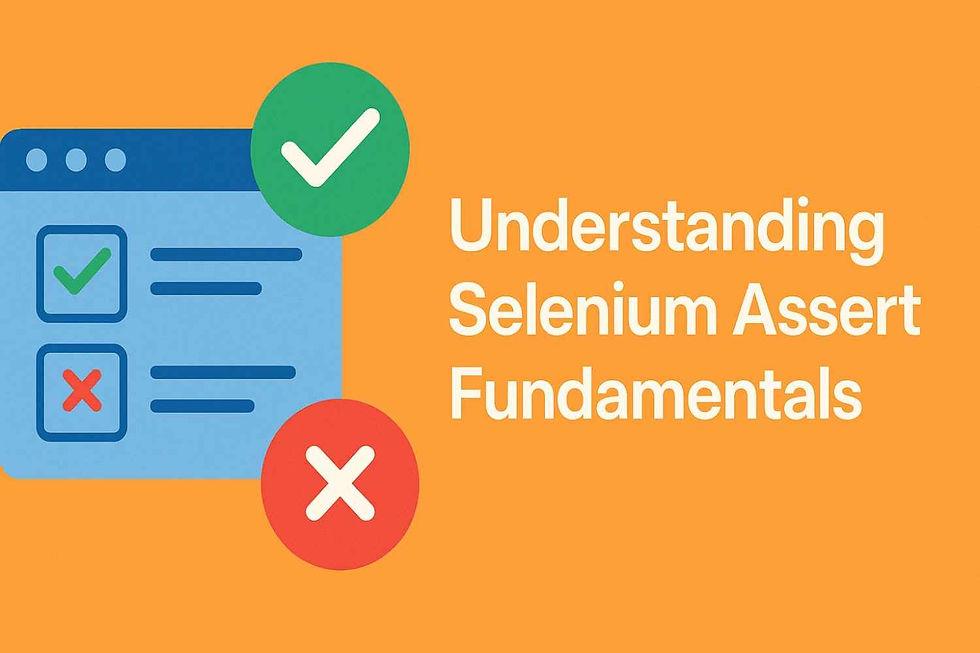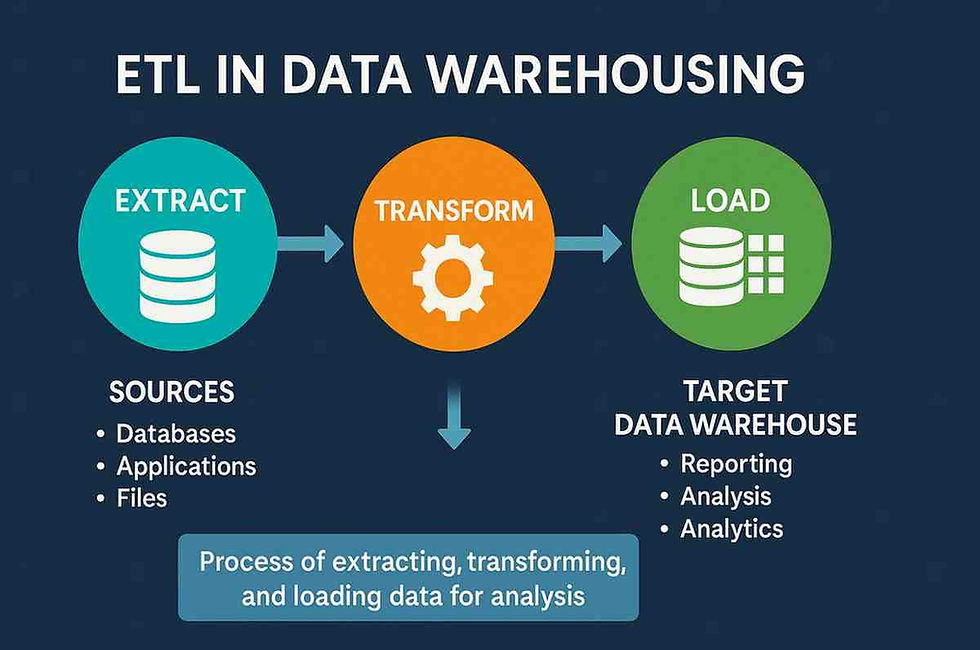Selenium Assert: Guide to Assertions in Test Automation
- Gunashree RS
- May 24
- 8 min read
Testing without proper validation is like building a house without checking if the foundation is solid. In the world of automated testing, Selenium assert statements serve as your quality checkpoints, ensuring that your web applications behave exactly as expected. Understanding how to implement and leverage assertions effectively can transform your testing strategy from basic automation to comprehensive quality assurance.
Assertions in Selenium testing act as the decision-makers in your test scripts. They evaluate whether specific conditions are met and determine the success or failure of your test cases. Think of them as your automated quality control inspectors, constantly verifying that every aspect of your web application functions correctly.
The power of Selenium assert lies not just in identifying when something goes wrong, but in providing clear, actionable feedback about what exactly failed and why. This capability makes assertions indispensable for creating reliable, maintainable test suites that genuinely protect your application's quality.
Understanding Selenium Assert Fundamentals
Selenium assert mechanisms provide the backbone for test validation in automated testing frameworks. Unlike simple print statements or logging, assertions create definitive pass/fail criteria that determine test outcomes and provide structured feedback about application behavior.
Core Assertion Concepts
At its essence, a Selenium assert compares an expected result with an actual result from your web application. When these values match, the assertion passes silently, allowing your test to continue. When they don't match, the assertion fails, typically stopping test execution and providing detailed error information about what went wrong.
This binary nature of assertions creates clear success criteria for your tests. Instead of manually reviewing logs or outputs to determine if tests passed, assertions provide automated, unambiguous results that can be easily integrated into continuous integration pipelines and automated reporting systems.
Assertion Types and Categories
Selenium testing frameworks typically support multiple types of assertions, each designed for specific validation scenarios. These range from simple equality checks to complex condition evaluations, providing flexibility for different testing requirements.
The choice between different assertion types depends on your specific testing needs, the testing framework you're using, and the level of control you want over test execution flow when failures occur.

Hard Assertions vs Soft Assertions: Critical Differences
Understanding the distinction between hard and soft assertions is crucial for designing effective test strategies. Each approach serves different purposes and offers unique advantages depending on your testing objectives.
Hard Assertions: Stop-on-Failure Approach
Hard assertions follow a strict approach where any assertion failure immediately stops test execution. When a hard assertion fails, the test case terminates, marking the entire test as failed and preventing subsequent assertions from running.
This behavior makes hard assertions ideal for scenarios where a fundamental requirement must be met before continuing with the test. For example, if a user's login fails, there's no point in continuing with tests that require an authenticated user session.
Hard assertions provide several key benefits:
• Clear failure points that immediately identify where tests break
• Faster test execution since failed tests stop immediately
• Simpler debugging with direct failure location identification
• Resource efficiency by not wasting time on dependent test steps
However, hard assertions also have limitations. They can miss multiple issues within a single test run, requiring multiple test executions to identify all problems in a test scenario.
Soft Assertions: Continue-on-Failure Strategy
Soft assertions take a more permissive approach, allowing test execution to continue even when assertion failures occur. These assertions collect failure information throughout the test execution and report all failures at the end of the test.
This approach proves particularly valuable when you want to validate multiple independent conditions within a single test case. For instance, when testing a form submission, you might want to verify multiple field validations, error messages, and UI states regardless of whether individual assertions fail.
Soft assertions offer distinct advantages:
• Comprehensive failure reporting showing all issues in a single test run
• Better test efficiency by identifying multiple problems simultaneously
• Detailed feedback for complex test scenarios with multiple validation points
• Reduced test execution time for identifying all issues in a test case
The trade-off with soft assertions is increased complexity in test logic and potentially confusing failure reports when multiple assertions fail simultaneously.
Essential Selenium Assert Methods and Implementation
Different testing frameworks provide various assertion methods, each designed for specific validation scenarios. Understanding these methods and their appropriate usage helps create more effective and maintainable test suites.
Equality and Comparison Assertions
The most fundamental assertions involve comparing expected and actual values. These include methods for checking exact equality, inequality, and various comparison operations.
assertEquals() methods verify that two values are exactly equal, making them perfect for validating text content, numeric values, or object states. These assertions form the foundation of most test validation scenarios.
assertNotEquals() methods ensure that two values are different, useful for validating that changes have occurred or that different test scenarios produce different results.
Boolean and Condition Assertions
Boolean assertions evaluate true/false conditions, making them ideal for validating element states, feature flags, or conditional logic within your application.
assertTrue() and assertFalse() methods provide straightforward validation for boolean conditions. These are particularly useful when working with element visibility, enabled states, or custom validation logic.
Null and Existence Assertions
Validating the presence or absence of elements, data, or objects requires specialized null-checking assertions. These methods help ensure that your application properly handles data initialization, element loading, and cleanup operations.
The assertNotNull() and assertNull() methods provide reliable validation for object existence scenarios, particularly important when dealing with dynamic content or conditional element rendering.
Collection and Array Assertions
Modern web applications often involve lists, arrays, or collections of data. Specialized assertions for these data structures help validate complex scenarios involving multiple elements or data sets.
These assertions can verify collection sizes, element presence within collections, or the order of elements in sorted lists.
Advanced Assertion Strategies and Techniques
Mastering basic assertions is just the beginning. Advanced assertion strategies involve combining multiple validation approaches, handling complex scenarios, and creating more sophisticated test validation logic.
Custom Assertion Development
Sometimes standard assertion methods don't perfectly match your specific validation requirements. Creating custom assertions allows you to encapsulate complex validation logic into reusable, expressive methods.
Custom assertions can combine multiple standard assertions, implement domain-specific validation rules, or provide more descriptive error messages tailored to your application context.
Assertion Chaining and Composition
Advanced testing scenarios often require multiple related validations. Assertion chaining techniques allow you to create fluent, readable test code that performs multiple validations in sequence while maintaining clear error reporting.
Conditional and Dynamic Assertions
Real-world applications often require conditional validation based on application state, user roles, or feature flags. Dynamic assertion techniques help create flexible tests that adapt their validation approach based on runtime conditions.
Performance and Timing Assertions
Beyond functional correctness, assertions can validate performance characteristics, response times, and timing-related behaviors. These specialized assertions help ensure that your application meets performance requirements consistently.
Best Practices for Selenium Assert Implementation
Implementing assertions effectively requires following established patterns and avoiding common pitfalls. These best practices help create maintainable, reliable test suites that provide genuine value for quality assurance.
Descriptive Error Messages
Every assertion should include clear, descriptive error messages that explain what was expected, what actually occurred, and why the failure matters. Well-crafted error messages dramatically reduce debugging time and improve test maintainability.
Assertion Granularity and Focus
Each assertion should validate a single, specific condition. Overly complex assertions that check multiple unrelated conditions create confusion when failures occur and make tests harder to maintain.
Strategic Assertion Placement
Position assertions at logical validation points throughout your test flow. This includes validating preconditions before important operations, checking intermediate states during complex workflows, and verifying final outcomes at test completion.
Framework-Specific Considerations
Different testing frameworks (TestNG, JUnit, pytest) provide different assertion capabilities and conventions. Understanding your framework's specific features helps you leverage the most appropriate assertion methods for your testing needs.
Common Pitfalls and Troubleshooting Techniques
Even experienced testers encounter assertion-related challenges. Understanding common problems and their solutions helps create more robust test automation strategies.
Timing and Synchronization Issues
Web applications often involve asynchronous operations that can cause assertions to execute before the expected conditions are met. Implementing proper wait strategies and synchronization techniques prevents timing-related assertion failures.
Flaky Assertion Patterns
Some assertion patterns are inherently unreliable due to their dependence on external factors, timing, or non-deterministic application behavior. Identifying and refactoring these patterns improves test reliability.
Assertion Overuse and Underuse
Finding the right balance of assertions requires experience and judgment. Too many assertions can make tests slow and brittle, while too few assertions may miss important validation opportunities.
Frequently Asked Questions
What's the difference between assert and verify in Selenium?
Assert methods stop test execution when they fail (hard assertions), while verify methods continue execution and collect failures for reporting at the end (soft assertions). Choose based on whether you need to stop immediately on failure or collect multiple validation results.
When should I use hard assertions versus soft assertions?
Use hard assertions for critical conditions that must pass before continuing (like successful login). Use soft assertions when you want to validate multiple independent conditions in a single test run (like multiple field validations on a form).
How do I create custom assertion messages in Selenium?
Most assertion methods accept an optional message parameter that will be displayed when the assertion fails. For example: assertEquals("Login should be successful", expectedText, actualText).
Can I use assertions with dynamic content that changes frequently?
Yes, but you'll need to use more flexible assertion strategies. Consider using partial text matching, regular expressions, or assertions that check for the presence of key elements rather than exact text matches.
Why do my assertions sometimes pass locally but fail in CI/CD pipelines?
This often indicates timing issues or environment differences. Implement explicit waits before assertions, ensure consistent test data, and consider browser/environment-specific behaviors that might affect assertion outcomes.
How many assertions should I include in a single test method?
Focus on testing one logical scenario per test method. The number of assertions depends on how many validation points are needed to confirm that the scenario works correctly. Generally, 3-7 assertions per test method are reasonable.
What happens if I don't include any assertions in my Selenium test?
Without assertions, your test will always pass unless it encounters an exception. Tests without assertions only verify that actions can be performed, not that they produce the correct results.
How do I handle assertions when testing across different browsers?
Use assertions that focus on functional behavior rather than browser-specific rendering details. Consider using flexible matching for text content and avoid assertions that depend on exact pixel measurements or browser-specific styling.
Key Takeaways
• Selenium assert methods are fundamental to creating reliable automated tests that provide clear pass/fail criteria and meaningful validation feedback
• Hard assertions stop execution immediately upon failure, making them ideal for critical preconditions, while soft assertions continue execution to collect multiple failures
• Proper assertion implementation requires descriptive error messages, appropriate granularity, and strategic placement throughout test workflows
• Different assertion types serve specific purposes including equality checks, boolean validations, null checks, and collection verifications
• Advanced assertion strategies involve custom assertion development, chaining techniques, conditional validation, and performance-based assertions
• Common pitfalls include timing issues, flaky assertion patterns, and improper balance between assertion coverage and test maintainability
• Best practices emphasize clear error messages, single-responsibility assertions, framework-specific optimization, and consistent validation patterns
• Troubleshooting assertion problems often involves addressing synchronization issues, environmental differences, and dynamic content challenges




Automation testers love discussing the flexibility of Selenium, especially for verifying UI behavior in complex builds. Collaboration between QA teams and developers can prevent a lot of repetitive bugs. When issues escalate, clarity matters, which is why reliable communication channels such as Unity Technologies phone number become valuable for developers troubleshooting plugin conflicts. Clear technical support reflects how professional ecosystems should function quick, precise, and transparent. In both open-source and commercial contexts, proper communication saves hours of debugging that documentation alone can’t solve.
Link INDOVIP138
indovip138
indovip138
indovip138
indovip138
indovip138
indovip138
indovip138
indovip138
indovip138
indovip138
indovip138
indovip138
indovip138
indovip138
indovip138
indovip138
indovip138
indovip138
indovip138
indovip138
indovip138
indovip138
indovip138
indovip138
indovip138
indovip138
indovip138
indovip138
indovip138
indovip138
indovip138
indovip138